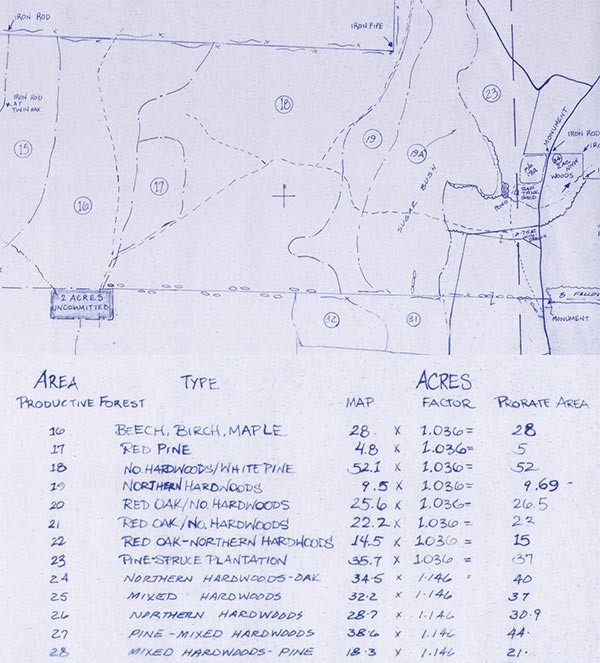In assaying wooded land, foresters observe, measure, describe, and map the forest, delineating it into smaller areas – or management units – known as stands. In this way, a forest is seen as a collection of distinct areas, typically ranging in size from a few acres to several hundred. In each stand, the trees share certain characteristics, usually species, age, size, arrangement, condition, or location – or some combination of these. A sugar maple stand, for example, would have a preponderance of sugar maple trees and is defined on the basis of species dominance. A northern hardwood pole-stand, on the other hand, is defined by a combination of attributes: species and size class. Another stand might be delineated based on the fertility and tree-growth potential of its soils, while yet another might be mapped based on its value as a particular habitat for wildlife.
There are endless such possibilities for stand delineation. Whatever the basis, once delineated, stands are usually numbered or named to help keep track of inventory, planned and completed activities, and measures of expenses, productivity, and revenue.
For each stand, the forester prescribes a particular set of silvicultural techniques to be applied in pursuit of the owner’s management objectives. This entire approach to delineating stands as uniform operational units was designed to make forest management more efficient, especially for timber production. This has been a foundation of our entire history of forestry. But more recently, its relevance has come into question.
Nowadays, for many, if not most, landowners, timber production is only a part – and sometimes a small part – of their forestland goals. Creating better wildlife habitat often comes first, but enhancing biological diversity, promoting forest health, providing for recreational use, and preserving the natural beauty of the land sometimes rank high as well.
At least partly in response to these expanding interests, new silvicultural approaches that encourage diversity and complexity are becoming more common, such as those designed to maintain two or more age classes of trees, and harvesting practices that include keeping scattered individuals or groups of trees to retain important functions like fruit and seed production, partial shade, and a variety of habitat attributes. This new emphasis on variability has caused some to ask whether forest stands – for which uniformity is a guiding principle – should be the basic subunits in silviculture. What’s more, they say, given the natural dynamism and inherent variability in forests, why would we expect – let alone demand – that stand boundaries be fixed in space and unchanging over time?
These are good questions to be sure, and they help us test our understanding of some important forestry concepts. But like forest stands themselves, the answers to these questions will need to go beyond the conceptual to include the pragmatic. The notion that foresters would want to break larger forest areas into smaller management units is still very sound. It makes good, practical, administrative sense. But our understanding of what a stand represents and how it is used in silviculture should evolve just as our understanding of forests and our silvicultural approaches and goals have changed.
With modern advances in GPS and ever easier to use digital mapping tools, foresters are better equipped than ever to characterize, map, and analyze the many important features of a forest. We no longer have to paint a picture of the forest and our silviculture plans for it with the same old broad brush. Instead, we can, and should, embrace the variety and change that define forests and strive to understand the richest details possible, while integrating them into the greater, changing whole.



Discussion *